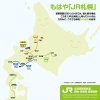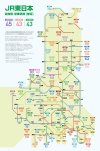Okay, maybe not quite but this is interesting!
From 'nippon.com':

 www.nippon.com
www.nippon.com
From 'nippon.com':
Tokyo, July 25 (Jiji Press)--An expert panel under Japan's transport ministry compiled Monday an outline for a proposal on the operations of train lines running through less populated areas in the country, many of which are currently struggling to stay afloat.
In the proposal, the panel included a plan to begin talks to review the operations of such "local train lines" with less than 1,000 daily passengers per kilometer on average.
Under the new system, the panel proposes that the central government will establish councils to discuss ways to review the operations of train lines that meet the criteria, based on requests from railway operators and municipalities hosting the railway lines in question.
The councils will decide within three years what actions to take.
By involving the central government in discussions between railway operators and local governments, which often have conflicting interests over the operations of local train lines, the panel hopes that the new system will help agreements be reached over rebuilding a sustainable public transportation system.

Japan to Review Operations of Train Lines with Less than 1,000 Users
Tokyo, July 25 (Jiji Press)--An expert panel under Japan's transport ministry compiled Monday an outline for a…
Last edited by a moderator:





